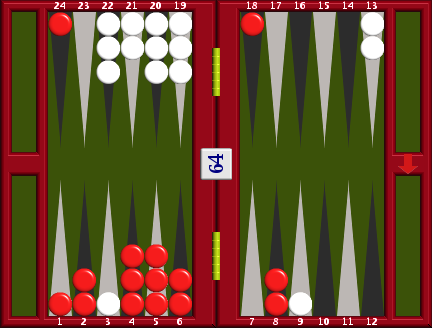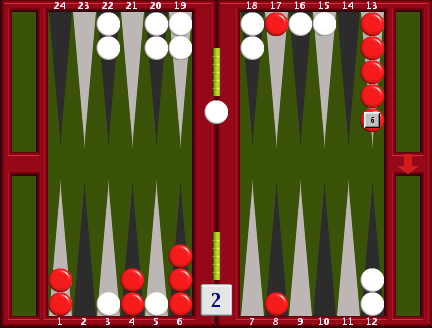News:
click the little + - buttons to customise your Fibsboard (unclick them sometimes to see what you're missing 
Posted in Backgammon articles
November 21, 2006, 11:40:00 AM
Written by dorbel
Views: 29600
Rating: 







 (Rates: 9)
(Rates: 9)








 (Rates: 9)
(Rates: 9)Improvers Corner Number Two
Last week we looked at a positional mid-game double. This week we look at an example of another type that draws huge mistakes from every class of player, the blitz. A blitz is any position where the attacker is shooting at one or more blots inboard in an effort to close them out. These always come with a large gammon threat and are usually very difficult to evaluate correctly. Take a look at this position.

Don’t be scared by blitzes. Learn to read the numbers and drop on data rather than an irrational fear of gammons.
Here’s another one, with Red on roll and owning the cube in a five point match. Three 1800+ players evaluated this as too good to double. Were they right?

What do the rollouts say about this position? If it was a money game, then Red would have a redouble and not turning the cube would be a small, although clear, error costing about 0.05 points. He wins this (in round figures) 64% including 35% gammons and 3% backgammons. On the other side White will win 36% including 10% gammons of her own. Passing would be a big blunder, costing 0.2 points.
In a five point match the decision will need to be different. Red is not quite good enough to double and doubling would be a small error, costing about 0.04 points. He is not yet “in the doubling windowâ€. This is a technical term. The window opens at the point at which you first have a correct double, that is the point at which your equity will increase if you turn the cube. In money play, the lower limit at which the window can open is 50%. In match play, it can be anywhere! The window closes at the point at which your opponent still has a correct take. If you are somewhere in the window and there are some sequences after which you will no longer be able to get a correct take (known as market losers), then you need to consider a double.
In this five point match, the simplest route to deciding our cube action is to look at whether or not White has a take. The hardest part of this is deciding whether or not this is a take for money and many good players would pass this for money, so let’s look at that first.
The easiest things to assess in a position are the things that can be counted. The pip count is in Red’s favour at 131 to 154, healthy but not yet overwhelming and it is not the most important feature of the position anyway. Blots and shots are easy to count too. White has been caught out with five vulnerable blots and Red can hit one or more of them with every number on the dice. This is enough to decide many White players against a take and they look no further, but we haven’t yet come to the positional features and they are of vital importance here. This is because both players need to be asking themselves, “How does Red plan to win this gameâ€. In fact pros ask this question (under their breath) quite a lot and this position demonstrates why.
(1) Red can blitz and go for a close-out. This often fails, because he doesn’t yet have enough checkers “in the zone†for this plan. He only has eight checkers in the home board or bearing on home board points, the same number that he started the game with. Of course he will hope to be bringing up reinforcements later, but the key to successful blitzing is that you keep hitting and/or making points without let up and that isn’t going to happen yet. When he does choose to hit loose, White’s stronger forward position will count for a lot if there is an exchange of hits.
(2) Red can bring his checkers home safely, usually against an anchor and occasionally against two. His checkers are not in position for this either, with a super-stack on the midpoint and no points in the outfield. This is an exceptionally weak and inflexible position.
(3) He can build a prime, but this is not very likely as he has two checkers out of play.
So Red has three alternative game plans, none of them particularly convincing and this argues very strongly for a take. He is on roll and in the lead and White has a man on the bar and four blots, so a double seems reasonable but hardly overwhelming. Note that White has fifteen checkers to play with, while Red has thirteen. This is quite an advantage as White will have more choice and flexibility than Red. Also, Red’s play is going to be considerably harder than White’s. He is likely to face a lot of tough plays from here, whereas White’s play is quite easy, enter, anchor and hit when you can! So marked is this difference in the skill required by either side, that a technically correct redouble here is almost certainly incorrect if Red is anything less than World Class!
Don’t believe me? How would you play 6-3 here? A lot of good players would play 13/7, 8/5* but this is a large error costing about 0.08 of a point and the best play is 17/8. How about 6-5? Yes, hitting is a blunder and you should play 17/11, 13/8. Hitting is also clearly wrong with 5-4. Notice that these plays lift the threat hanging over White’s outfield blots, indicating that the threat to hit them wasn’t especially damaging for White anyway. So, technically a redouble and an easy take for money. Why should our five point match be different? Very largely, it is because the greater part of Red’s advantage lies in his gammon threat, but the gammons aren’t very useful for him. Three of the four extra points for a gammon are completely wasted, technically known as overage, while his backgammons are totally useless. Closing out four or five checkers can be a double-edged sword if the backgammon doesn’t count.
If White passes this position, she will trail 5-away, 3-away (0-2 to 5) and her match equity will be 36%. As she can hope to win this game 36% of the time, she has a take of this cube even if she adopts the mindless strategy of taking and redoubling immediately to nullify gammons entirely. Clearly she can do a great deal better than this if she waits and uses the cube correctly later, or alternatively loses a plain game and retains her 15% equity at Crawford, 5-away. Pretty clearly too, Red does a lot better to wait for a better opportunity later. However, gammonish positions like this one rarely provide Red with a good doubling opportunity. He will often be not good enough until he gets a very good sequence, after which he becomes too good!
Learn anything? Play this one out with a practice buddy and you’ll learn a lot more.
Until next week, Enjoy the Game!
Comments: 3

Comment by molke on January 19, 2007, 05:51:24 PM
wow, what a good analyse
Comment by markeemark on October 29, 2007, 01:10:57 AM
How is that I can only see three quarters of the text?, it looks like a great article but I cant read it all
Comment by lewscannon on February 07, 2014, 07:56:02 PM
Interesting analysis of 1st example. I can't imagine that would be a take for white, but I guess your statistics don't lie
You don't have permission to comment, or comments have been turned off for this article.
Articles in « Backgammon articles »
- What is backgammon?
- Backgammon code
- Improvers Corner Number One
- Improvers Corner Number Two
- Improver's Corner number three.
- Improvers Corner Number Four.
- What are your chances?
- An introduction to Tournament Backgammon
- Takhteh-Nard
- dorbel versus BushSucks Game One
- dorbel versus BushSucks Game Two
- dorbel versus BushSucks Game Three
- gnubg gammonline html output test
- Equity
- In doubt Capture
- Decision Analysis for Success - a course for students?
- New Dorbel Daily No 1.

 Sited by SoulTrade
Sited by SoulTrade